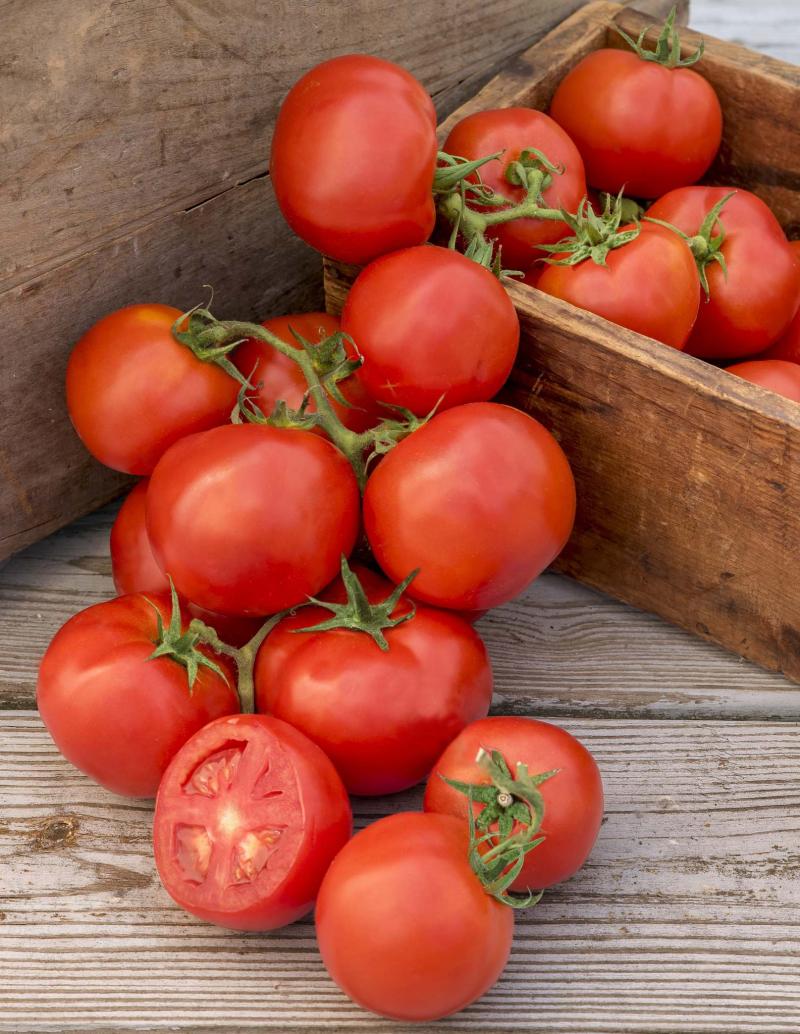
Burpee Seeds
For tomatoes, cut lower branches to improve airflow. Remove leaves at first sign of infection.

Colleen Zacharias / Winnipeg Free Press
There is new hope for the lily in the war against the lily leaf beetle. A tiny parasitic wasp is showing promise in test gardens in Winnipeg and near Stonewall.

Burpee Seeds
Kale has isothiocyanate properties, which can attract flea beetles to your garden.

All America Selections
Thinning your carrots may reduce your yield, but the reward is bigger, plumper carrots.

Vineland Research
For beautiful, healthy roses, monitor your plants for early signs of pests or disease.
Pests and disease in the flower or vegetable garden can cause serious damage to plants. Your best defence starts well before signs of an infestation or disease problem, but even with careful selection of disease-resistant plants, cultural practices such as ideal soil conditions, adequate light and good air circulation, troubles can occur.
Ian Wise, a local entomologist, says that once a pest infestation or plant disease is well underway in the home garden, the expectation that chemical controls are the answer is unrealistic. Monitoring your plants regularly from the outset of growth allows for the opportunity to effectively control pests and diseases at the early stages. A long-term management strategy is the best weapon in the pest control arsenal.
Born and raised on a small acreage in B.C. where his family grew nearly all of their own fruits and vegetables, Wise served as the provincial research co-ordinator at Hoescht Canada before moving to Winnipeg, where he worked as a research biologist at the Cereal Research Centre for 25 years. There he worked with a team of entomologists and crop breeders who discovered the only known source of resistance to the wheat midge and, in addition, developed wheat varieties with resistance to this harmful pest.
One of the pests currently occupying Wise’s attention is the lily leaf beetle. As part of a research effort under the direction of Naomi Cappuccino, associate professor at Carleton University, Wise is studying the impact of a tiny parasitic wasp, Tetrastichus setifer, on the lily leaf beetle. The lily beetle also feeds on Fritillaria, a genus of plants in the lily family, and on Solomon Seal (Polygonatum), although it only lays its eggs on lilies.
T. setifer was introduced into two sites in Manitoba, one in Winnipeg and the other near Stonewall. Wise says there is some positive news on the lily beetle front. "The wasp was observed parasitizing the beetle larvae," Wise says. "It’s now a matter of observing if the wasp overwinters in the parasitized larvae of the beetle and emerges next year. If parasitized beetles are found next year, then we know the parasites can overwinter and become a permanent means of reducing lily beetle populations."
In the meantime, spraying with pyrethrin can be an effective strategy when used properly, Wise says. Pyrethrin has a biological origin — it is found naturally in some species of the chrysanthemum and is extremely safe to use for the gardener. The key is to get good coverage and to make contact with the larvae which are found on the undersides of leaves. This is difficult at best. Controlling pest populations at the outset (picking and squishing) is an easier solution. Avoid using carbaryl, the active ingredient in chemical products such as Sevin, as it is highly toxic to pollinators.
I’m intrigued by a method used by Walt Pett, a University of Michigan professor in entomology, who researches the Colorado potato beetle. To sample insects for his research, Pett removes insect pests from potato plants by vacuuming them up with a leaf blower. I asked Wise if a hand-held cordless vacuum would do the trick against the lily beetle. Wise believes it could be effective but the focus would need to be on the adults primarily. The larvae are pretty objectionable in terms of the fecal material that they retain on their brightly coloured backs as a way of discouraging predators. Wise suggests laying a white sheet on the ground since the beetles have a way of disguising themselves from detection by falling on their backs and exposing only their black undersides — impossible to see against soil.
The beetle generally overwinters in leaf litter that is in close proximity to where lilies are growing. Since gardeners are always thinking ahead to the next growing season, plan to disturb the overwintering site. By raking off the leaves early in spring, beetles are exposed to warm temperatures and emerge prior to the availability of their food source. This can help to minimize the problem for your garden as they fly off in search of food somewhere else.
Roses can be targets of numerous pests. Symptoms of disease, too, spoil the beauty of a rose. Rose sawfly is a flying insect that is yellow-green in colour. It feeds on the undersides of the leaves of roses. When leaves are severely skeletonized resulting in defoliation, the plant is weakened. I have found dormant oil (a combination of horticultural oil and lime sulphur) to be very effective against rose sawfly, as well as scale insects and over-wintering fungus disease.
A safe, non-toxic measure, it’s important to apply a dormant oil spray in early spring, says Wise, when plants are completely dormant and leaf buds have not yet begun to swell. Since the sawfly overwinters in the soil, clean up debris in the fall as a preventative measure, taking care to destroy any diseased plant material.
The rose curculio weevil is a nasty pest that lays its eggs inside flower buds. When the larvae hatch, they feed on the buds from the inside out causing unsightly damage. Prune off the bud, says Wise, and discard it carefully so that the weevil doesn’t return to your garden next year.
In the vegetable garden the practice of seeding too densely results in a number of problems, says Wise. Plants are weakened and become susceptible to disease if they must constantly compete for moisture and light. In addition, yields are reduced. It’s important to ensure proper spacing when seeding but also to remove weed growth. In the example of carrots, thinning your crop is essential. You will yield fewer carrots but they will be much bigger.
Once a plant begins to show any degree of disease, says Wise, remove the affected leaves to prevent them from becoming a potential source of infection which can spread to the rest of the plant. In the example of tomatoes, lower branches should be pruned off early, says Wise. Often, though, this practice is left too late. Removing the lower branches on a timely basis helps to provide more movement of air through the plant, which keeps it drier and lessens the likelihood that disease will become established.
One of the most important cultural practices in the vegetable garden is sanitation. In the fall, remove any infected plant material, some of which can be infested with overwintering insects. Tomato foliage must be discarded because tomatoes can be susceptible to verticillium, a soil-borne fungus.
Some plant material, such as beans and peas which fix nitrogen in the soil, can be dug back into the garden at the end of the season. Kale, however, has isothiocyanate properties which can attract flea beetles to your garden.
Look at gardening as a challenge, says Wise. Get to know your plants better, provide them with the growing conditions they need, and monitor regularly for signs of trouble so that you can minimize insects and disease safely and effectively.
colleenizacharias@gmail.com
On July 22, rain or shine, the Carman Garden Club will host its annual garden tour from 1 p.m. to 5 p.m. Registration is from 12:30 p.m. to 2:30 p.m. at the Carman Dufferin Museum, 215 4th Ave., Carman.



